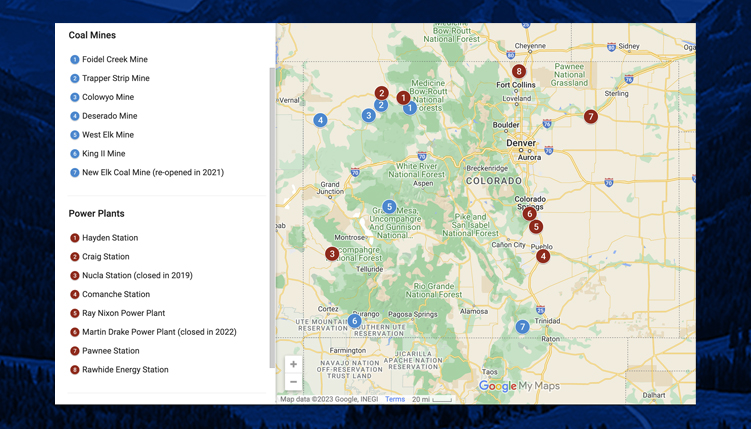Coal in Colorado
Coal has been central to Colorado’s growth and economy since before statehood.
It has heated our homes, powered our railways, fueled our industries and, ultimately, generated most of our electricity. Along the way it built fortunes, defined communities, and even galvanized the labor movement in Colorado and around the country. More than 1,700 coal mines have operated in Colorado at one time or another over the last 160 years, from Larimer and Las Animas counties in the east to Moffat and Montezuma counties in the west. And generations of Colorado workers and their families have been proud to make their livings powering our prosperity by mining, transporting, and burning coal.
Today, coal is mostly used to generate electricity in Colorado. And for a variety of reasons, the use of coal has been declining for more than a decade. That trend is likely to accelerate.
Eight coal-fired electrical power generating plants remained in Colorado in 2019. One (in Nucla) closed in September of that year, and another (in Colorado Springs) converted to natural gas in 2021 before closing completely in 2022. The remaining six plants are scheduled to close or convert between 2024 and the end of 2030.
The plans for Colorado's seven remaining coal mines are less clear.
But markets are disappearing and they all face uncertain futures. Some may close when the nearby power plants they supply close. The era of coal in Colorado appears to be ending, and that poses serious challenges to the workers and communities that rely on it.
In 2019, the Colorado General Assembly passed and Governor Jared Polis signed legislation creating the Office of Just Transition and the Just Transition Advisory Committee and making a “just transition” for these workers and communities a state priority. The General Assembly has passed several additional bills since then, and the current statute governing OJT can be found in Title 8 of the Colorado Revised Statues.
Boom and bust cycles have always been a part of Colorado’s energy economy. But for the first time, the state is committed to not walk away from the workers and communities that stand to lose the most.
Operating Coal Mines
| Name | Location | Employees (as of October 2022) | Production (2021) |
|---|---|---|---|
| Foidel Creek Mine Twentymile Coal Co. | Routt County | 168 | 1.74 million tons |
| Trapper Mine Trapper Mining Inc. | Moffat County | 105 | 1.57 million tons |
| Colowyo Coal Mine Tri-State Generation and Transmission | Moffat County | 173 | 2.2 million tons |
| Deserado Mine Blue Mountain Energy | Rio Blanco County | 153 | 2.71 million tons |
| West Elk Mine Mountain Coal Co. | Gunnison County | 284 | 3.28 million tons |
| King II Mine GCC Energy | La Plata County | 92 | 0.47 million tons |
New Elk Mine | Las Animas County | 80 | 0.17 million tons |
Operating Coal-Fueled Electrical Power Plants
| Name | Location | Closure | Employees (current) | Property Taxes as Percentage of DISTRICT Total in 2022 |
|---|---|---|---|---|
| Hayden Station Xcel Energy | Routt County | Unit 1: 2028 (approved) Unit 2: 2027 (approved) | 74 | 14.8% |
| Craig Station Tri-State Generation and Transmission | Moffat County | Unit 1: December 2025 (approved) Unit 2: September 2028 (approved) Unit 3: January 2028 (announced) | 153 | 33.7% |
| Comanche Station Xcel Energy | Pueblo County | Unit 1: 2023 (approved) Unit 2: 2026 (approved) Unit 3: 2031 (approved) | 150 | 11.8% |
| Ray Nixon Power Plant Colorado Springs Utilities | El Paso County | by 2030 (announced) | 166 (combined number with Martin Drake Plant) | 0% |
| Pawnee Station Xcel Energy | Morgan County | 2026 (converting to natural gas)(approved) | 79 | 22.8% |
| Rawhide Energy Station (Unit 1) Platte River Power Authority | Larimer County | by 2030 (announced) | 100 |
Closed Coal-Fueled Electrical Power Plants (since 2019)
| Name | Location | Closure | Employees (current) |
|---|---|---|---|
| Nucla Station Tri-State Generation and Transmission | Montrose County | September 19, 2019 | 58 |
| Martin Drake Powerplant Colorado Springs Utilities | El Paso County | Converted to Natural Gas August, 2021; Closed September, 2022 | 166 (combined number with Ray Nixon Plant) |
Note on Closure dates:
- approved means approved by the Public Utilities Commission
- announced means announced by the operating utility
Sources:
- Mine employment and production numbers from regular mining companies’ reports to the Division of Reclamation, Mining, and Safety at the Colorado Department of Natural Resources.
- Power plant closure dates from utility resource plans approved by the Colorado Public Utilities Commission or public announcements from utilities.
- Utility employment numbers from utility documents, including workforce transition plans submitted to the OJT, press releases and web sites.
- Property tax percentages from the Colorado Department of Local Affairs, Division of Property Taxation 2019 Forty-Ninth Annual Report to the Governor and General Assembly.
